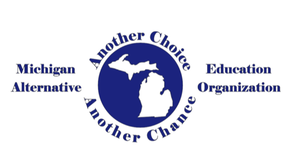What is alternative education?
The definition of alternative education recommended for adoption by the Michigan Department of Education is:
A separate program within a K-12 public school district or charter school established to serve and
provide youth a choice or option whose needs are not being met in the traditional school setting.
There are three indispensable goals for alternative schools:
1. That students attend by choice.
2. That the school or program be responsive to unmet local needs.
3. That the student body reflect the racial and socio-economic mix of the community.
http://www.michigan.gov/mde/0,4615,7-140-28753_65799_40027---,00.html
Alternative Education at the National and State Levels
All students have aspirations and all deserve the chance to choose an educational setting consistent with their learning styles. Beginning in the 1960's, America's alternative schools began exploring innovative techniques in order to provide appropriate instructional settings for students in need of additional educational opportunities. At present the alternative education effort in the United States serves an estimated four million students, or approximately 7% of the total public school population.
Michigan has been in the forefront of the alternative education movement since the beginning. Across the state, the concept of providing an intimate educational setting responsive to student and community needs has flourished. There are now more than 369 alternative education programs, in 270 school districts throughout Michigan. These programs collectively serve nearly 25,000 students, or about 5% of the total secondary school population in the state. While all programs work to help at-risk students complete their secondary education, they exhibit incredible variety and diversity in terms of size, focus, philosophy and structure.
http://the-naea.org/NAEA/
The definition of alternative education recommended for adoption by the Michigan Department of Education is:
A separate program within a K-12 public school district or charter school established to serve and
provide youth a choice or option whose needs are not being met in the traditional school setting.
There are three indispensable goals for alternative schools:
1. That students attend by choice.
2. That the school or program be responsive to unmet local needs.
3. That the student body reflect the racial and socio-economic mix of the community.
http://www.michigan.gov/mde/0,4615,7-140-28753_65799_40027---,00.html
Alternative Education at the National and State Levels
All students have aspirations and all deserve the chance to choose an educational setting consistent with their learning styles. Beginning in the 1960's, America's alternative schools began exploring innovative techniques in order to provide appropriate instructional settings for students in need of additional educational opportunities. At present the alternative education effort in the United States serves an estimated four million students, or approximately 7% of the total public school population.
Michigan has been in the forefront of the alternative education movement since the beginning. Across the state, the concept of providing an intimate educational setting responsive to student and community needs has flourished. There are now more than 369 alternative education programs, in 270 school districts throughout Michigan. These programs collectively serve nearly 25,000 students, or about 5% of the total secondary school population in the state. While all programs work to help at-risk students complete their secondary education, they exhibit incredible variety and diversity in terms of size, focus, philosophy and structure.
http://the-naea.org/NAEA/

